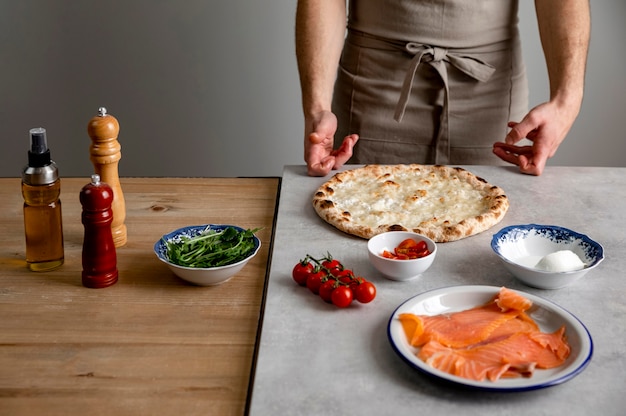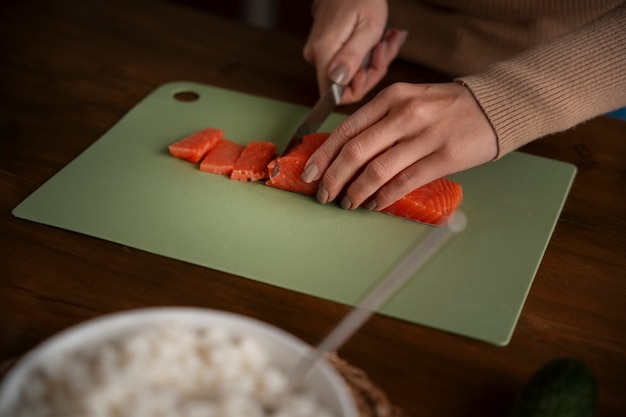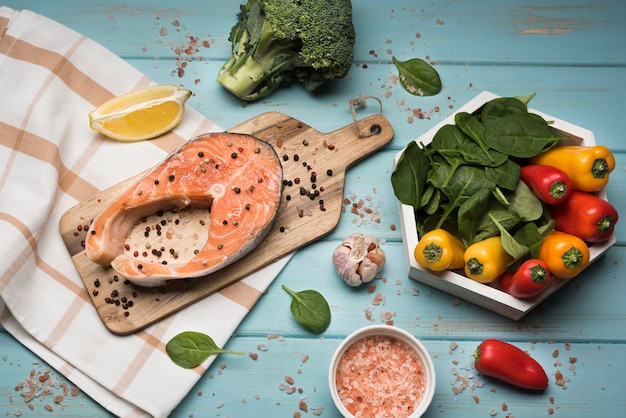Salmon. Oh, salmon. Just the name sends a shiver of excitement down my spine, conjuring up images of glistening, pink flesh and that irresistible, delicate aroma. There's a reason it's a favourite amongst home cooks and professional chefs alike. As a seasoned cook, I've spent years mastering the art of salmon, and there's nothing quite like sinking my teeth into a perfectly cooked fillet – flaky, moist, bursting with flavour, and utterly divine. But let's be honest, nailing that perfect cook can be a bit of a challenge, especially if you're a newbie to the world of fish. overcooked salmon? It's a tragedy in the kitchen – dry, tough, and a real let-down. But fear not, dear reader! In this comprehensive guide, I'm going to spill all the secrets I've learned over the years, turning you into a salmon-cooking maestro in no time.
(Part 1) Understanding Salmon: A Deeper Dive

Before we get into the nitty-gritty of cooking times, let's take a closer look at the star of our show – the salmon itself. This versatile fish comes in a vast array of forms, from fillets and steaks to whole fish, each with its own unique charm. But for our guide, we'll focus on the most popular type – the beloved salmon fillet.
The Anatomy of a Salmon Fillet
A salmon fillet is essentially a boneless, skin-on piece of salmon, usually cut from the side of the fish. You'll often find them sold with the skin on, which acts like a protective barrier, keeping the fish moist and flavourful during cooking. You can, of course, remove the skin before cooking (some people prefer it that way!), but I find leaving it on adds a lovely bit of texture and flavour. It's like a little bonus!
types of salmon: A Flavour Spectrum
The world of salmon is diverse and delicious, with many different types, each boasting its own unique flavour and texture. Here's a rundown of some of the most popular varieties:
- atlantic salmon: The most common type you'll find in supermarkets, Atlantic salmon is known for its rich, buttery flavour and firm, satisfying texture. It's a true crowd-pleaser.
- sockeye salmon: This salmon is a real treat! With its vibrant red flesh and intense flavour, it's a favourite amongst salmon connoisseurs. It's a bit like the rockstar of the salmon world.
- coho salmon: Coho salmon has a milder flavour compared to sockeye, with a slightly softer texture. If you're looking for a more delicate salmon experience, this is your go-to choice.
- chinook salmon: The largest of the pacific salmon, Chinook is known for its rich, buttery flavour and firm texture. It's a real heavyweight in the salmon world.
- pink salmon: Pink salmon boasts a mild flavour and delicate texture, making it a great option for grilling or smoking. It's a bit like the versatile, everyday salmon.
No matter which type of salmon you choose, the basic principles of cooking remain the same. It's all about respecting the fish and understanding its unique needs.
(Part 2) The Thickness Factor: Crucial for Perfect Results

Here's the thing about cooking salmon: thickness is king! It's the single most important factor in determining how long you need to cook it. Thin fillets, they cook like a flash, while thick fillets take a bit more time. It's easy to overcook a thin fillet, leaving it dry and sad. Thick fillets, on the other hand, can be a challenge to get perfectly cooked throughout.
Think of it like this: a thin fillet is like a pancake, while a thick one is like a burger. You wouldn't cook a pancake for the same amount of time as a burger, would you? The same logic applies to salmon!
How to Judge Your Salmon's Thickness: A Handy Guide
To gauge the thickness of your salmon, use your finger as a handy guide. Here's how to break it down:
- Thin Fillet: About the thickness of your pinky finger.
- Medium-Thick Fillet: About the thickness of your thumb.
- Thick Fillet: About the thickness of your palm.
Keep in mind, this is just a rough guide, so it's always best to check for doneness with a thermometer, especially for thicker fillets. You want to make sure that delicious salmon is cooked perfectly through and through!
(Part 3) The Art of salmon doneness: A Visual and Sensory Guide

Now, let's talk about that crucial concept of doneness. There's a reason why perfectly cooked salmon is a culinary masterpiece: lusciously pink interior, just a touch of browning on the outside, and a texture that melts in your mouth. But how do you know when it's reached that coveted state of perfection?
The Visual Guide to Salmon Doneness: From Raw to Well-Done
Here's a simple visual guide to help you know when your salmon is cooked just right:
- Raw: The salmon will be completely raw, with a translucent, greyish colour.
- Rare: The centre of the salmon will be translucent, with a beautiful pink colour. The edges will be slightly opaque and have a firm texture.
- Medium Rare: The centre of the salmon will be mostly opaque, with a vibrant pink colour. The edges will be well-cooked and opaque, with a firmer texture.
- Medium: The centre of the salmon will be opaque and have a slightly orange colour. The edges will be well-cooked and opaque, with a firm texture.
- Well-Done: The entire salmon will be opaque, with an orange colour. It will have a dry and flaky texture.
Remember: Most people prefer salmon cooked to medium or medium-rare, but ultimately, your personal preference will determine how you cook it. I'm a big fan of medium-rare, but that's just me!
The Thermometer: Your Trusty Guide
While the visual guide is a good starting point, the most reliable way to ensure perfect doneness is with a trusty food thermometer. Insert it into the thickest part of the salmon, making sure it doesn't touch the bone.
Here are the recommended internal temperatures for salmon, based on your desired level of doneness:
| Doneness | Internal Temperature (°F) | Internal Temperature (°C) |
|---|---|---|
| Rare | 120-125 | 49-52 |
| Medium Rare | 125-130 | 52-54 |
| Medium | 130-135 | 54-57 |
| Well-Done | 140-145 | 60-63 |
Once the salmon reaches the desired internal temperature, remove it from the heat. It will continue to cook slightly as it rests, so don't worry about it being a tiny bit undercooked when you take it off the heat.
(Part 4) Cooking Methods: A Symphony of Flavors
The beauty of salmon lies in its versatility. There are countless ways to cook it, each resulting in a unique symphony of flavours and textures. Here are a few of my favourite methods, each with its own distinct charm.
1. Pan-Seared salmon: Quick, Crispy, and Delicious
Pan-searing is a quick and easy way to cook salmon, delivering a crispy skin and a juicy, flavorful interior. It's perfect for weeknight dinners when you want something simple, elegant, and utterly satisfying.
Pro Tip: Heat your pan over medium-high heat and add a tablespoon of oil. Season the salmon generously with salt and pepper. Place the salmon, skin-side down, in the pan and cook for 3-4 minutes per side, or until the skin is crispy and the salmon is cooked to your liking. The key is to let the skin get a nice, even sear without moving it around too much.
2. Oven-baked salmon: Versatile and Easy
baking salmon is another simple and versatile cooking method, perfect for cooking multiple fillets at once. It allows you to get creative with flavour combinations, adding vegetables, herbs, or even a lemon-butter sauce to elevate your dish.
Pro Tip: Preheat your oven to 400°F (200°C). Line a baking sheet with parchment paper. Season the salmon generously with salt and pepper. Place the salmon, skin-side down, on the baking sheet and bake for 12-15 minutes, or until the salmon is cooked to your liking. You can also add a splash of water to the bottom of the baking sheet to create a bit of steam, which helps keep the salmon moist.
3. grilled salmon: Smoky Flavour and Outdoor Delight
Grilling salmon is a delightful way to enjoy the smoky flavour of the grill, perfect for summer barbecues or any time you want to bring the outdoor cooking experience indoors.
Pro Tip: Preheat your grill to medium heat. Season the salmon generously with salt and pepper. Place the salmon, skin-side down, on the grill and cook for 4-6 minutes per side, or until the salmon is cooked to your liking. Keep an eye on it, as grilling can get a bit intense. You can also try grilling the salmon over indirect heat, which helps prevent it from burning.
4. poached salmon: Gentle Cooking for a Delicate Flavour
Poaching salmon is a gentle, elegant cooking method that results in a tender and delicate fish. It's a great option for those who prefer a lighter and healthier cooking method, letting the natural flavours of the salmon shine through.
Pro Tip: Bring a pot of water to a simmer. Add a few slices of lemon, a sprig of dill, and some black peppercorns to the water. Gently place the salmon in the water and cook for 5-7 minutes, or until the salmon is cooked to your liking. The aromatics infuse the water with flavour, making your salmon even more delicious.
5. sous vide salmon: Precision Cooking for Perfection
sous vide cooking is a precise and consistent way to cook salmon, ensuring that it's cooked evenly throughout. It involves sealing the salmon in a vacuum bag and immersing it in a water bath at a specific temperature. This method results in perfectly cooked salmon, every time.
Pro Tip: Preheat your water bath to 125°F (52°C). Season the salmon generously with salt and pepper. Seal the salmon in a vacuum bag and submerge it in the water bath for 15-20 minutes, or until the salmon is cooked to your liking. The temperature-controlled environment ensures that your salmon is cooked to perfection, without any risk of overcooking.
(Part 5) Cooking Times: A Guide for Every Thickness
Now, let's get to the heart of the matter: the actual cooking times! Remember, these are just guidelines, and your specific cooking time may vary depending on the thickness of your salmon, the cooking method, and your oven or grill. It's best to err on the side of caution, checking for doneness frequently.
Thin Salmon Filets (Pinky Finger Thickness)
Pan-Seared: 3-4 minutes per side
Oven-Baked: 10-12 minutes
Grilled: 3-4 minutes per side
Poached: 4-5 minutes
Sous Vide: 10-12 minutes
Medium-Thick Salmon Filets (Thumb Thickness)
Pan-Seared: 4-5 minutes per side
Oven-Baked: 12-15 minutes
Grilled: 4-6 minutes per side
Poached: 6-8 minutes
Sous Vide: 15-20 minutes
Thick Salmon Filets (Palm Thickness)
Pan-Seared: 6-8 minutes per side
Oven-Baked: 15-20 minutes
Grilled: 6-8 minutes per side
Poached: 8-10 minutes
Sous Vide: 20-25 minutes
Remember: Always use a thermometer to ensure your salmon is cooked to your liking. Don't be afraid to check early and often!
(Part 6) The Art of Resting: Patience is a Virtue
Once your salmon is cooked, don't be tempted to dive right in! Resist the urge and allow it to rest for a few minutes before you cut into it. This is a crucial step, allowing the juices to redistribute throughout the fish, resulting in a more tender and flavorful piece of salmon.
Pro Tip: Cover the salmon loosely with foil and let it rest for 5-10 minutes before serving. This will create a warm, moist environment, ensuring that your salmon stays juicy and delicious.
(Part 7) Flavour Fusion: Beyond the Basics
Now that you've mastered the basics of cooking salmon, let's talk about taking your salmon game to the next level. There are endless possibilities when it comes to seasoning and flavouring your salmon. Here are a few ideas to get your creative juices flowing:
Herbs and Spices: Aromatic Delights
Start with the classics: salt and pepper. A good pinch of each is essential for bringing out the natural flavours of the salmon. Then get creative with fresh herbs like dill, parsley, chives, and thyme. For a more intense flavour, try adding a pinch of paprika, cayenne pepper, or cumin.
Citrus: A Burst of Bright Flavour
Lemon and lime are excellent choices for seasoning salmon. You can add slices of lemon or lime to the pan or grill, or simply squeeze some juice over the salmon before cooking. This adds a bright, tangy flavour that complements the richness of the salmon beautifully.
Sauces: Elevating Your Salmon
Salmon pairs well with a variety of sauces, such as lemon butter sauce, honey mustard sauce, or teriyaki sauce. You can also make a simple sauce from olive oil, lemon juice, and herbs. A touch of sauce can transform your salmon into a culinary masterpiece.
Glazes: Sweet and Savory Harmony
For a sweet and savoury flavour, try glazing your salmon with a mixture of honey, soy sauce, and ginger. Or, for a more tangy glaze, try a mixture of orange juice, honey, and Dijon mustard. Glazing adds a beautiful sheen and a layer of flavour that takes your salmon to the next level.
(Part 8) Leftovers: A Second Chance for Flavour
If you have leftover salmon, don't despair! It's a great ingredient for salads, sandwiches, or pasta dishes. You can also use it in a salmon dip or spread. Leftover salmon is a culinary treasure waiting to be reimagined!
Salmon Salad: Fresh and Delicious
Flake the leftover salmon and mix it with chopped cucumber, red onion, and a lemon vinaigrette. Serve on a bed of lettuce or in a sandwich. It's a refreshing and satisfying meal.
Salmon Pasta: A Creamy Delight
Add leftover salmon to your favourite pasta dish. It pairs well with pesto, cream sauce, or a simple tomato sauce. This is a quick and easy way to transform leftover salmon into a delicious pasta dish.
Salmon Dip: Creamy and Savoury
Mix leftover salmon with cream cheese, mayonnaise, and chopped dill. Serve with crackers or vegetables. It's a tasty and elegant appetizer that's sure to impress your guests.
FAQs: Your Salmon Questions Answered
1. How do I know if my salmon is done?
The best way to know if your salmon is done is to use a food thermometer. Insert it into the thickest part of the salmon, making sure it doesn't touch the bone. The internal temperature should be 125°F (52°C) for medium-rare, 130°F (54°C) for medium, and 140°F (60°C) for well-done.
2. What happens if I overcook salmon?
Overcooked salmon will be dry, tough, and not very flavorful. If you accidentally overcook your salmon, it's best to serve it with a sauce or topping that will add moisture and flavour.
3. Can I cook salmon from frozen?
You can cook salmon from frozen, but it will take longer to cook. Make sure to thaw the salmon completely in the refrigerator before cooking. Never thaw salmon at room temperature, as this can lead to bacteria growth.
4. Can I eat the skin on salmon?
Yes, you can eat the skin on salmon. It's actually quite delicious! The skin adds a bit of extra flavour and texture to the dish. It's a great source of omega-3 fatty acids too!
5. How do I store leftover salmon?
Store leftover salmon in the refrigerator in an airtight container for up to 3 days. You can also freeze leftover salmon for up to 3 months.
I hope this guide has helped you conquer your salmon cooking fears and embark on a journey of delicious flavour! Remember, the key to perfect salmon is all about understanding the fish, mastering the timing, and having a little fun in the kitchen. So go forth, cook some salmon, and enjoy!
Everyone is watching

Corn on the Cob: The Ultimate Guide to Perfectly Cooked Ears
Healthy MealsAh, corn on the cob. Just the name evokes images of sunny days, barbecues, and that sweet, juicy flavour that ...

Perfect Pork Roast Oven Cooking Time: A Guide to Delicious Results
Healthy MealsThere's something truly satisfying about a perfectly roasted pork. The aroma alone is enough to make your mout...

Ham Cooking Time: How Long to Bake, Smoke, or Boil a Delicious Ham
Healthy MealsAh, ham. It's a classic, isn't it? A real crowd-pleaser, especially around holidays. And when done right, it'...

Scallops: The Ultimate Guide to Perfect Cooking
Healthy MealsAh, scallops. Those delicate, sweet, and utterly delicious morsels of the sea. They hold a special place in my...

Spaghetti Squash: The Ultimate Guide to Cooking and Serving
Healthy MealsRemember that time you saw spaghetti squash at the supermarket, looking all bumpy and strange, and thought, "W...
